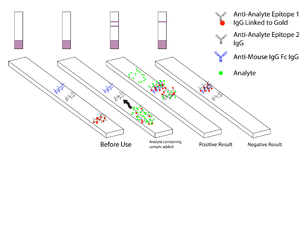- Dipstick
-
A dipstick is one of several measurement devices.
Some dipsticks are dipped into a liquid to perform a chemical test or to provide a measure of quantity of the liquid.
In the late 20th century, a flatness/levelness measuring device trademarked "Dipstick" was used to help establish profile measurement standards in the concrete floor and paving industries.
Contents
Testing dipstick
A testing dipstick is usually made of paper or cardboard and is impregnated with reagents that indicate some feature of the liquid by changing color. In medicine, dipsticks can be used to test for a variety of liquids for the presence of a given substance, known as an analyte.[1] For example, urine dipsticks are used to test urine samples for haemoglobin, nitrite (produced by bacteria in a urinary tract infection), protein, glucose and occasionally urobilinogen or ketones.
They are usually brightly-coloured, and extremely rough to touch.
Measuring dipstick
Dipsticks can also be used to measure the quantity of liquid in an otherwise inaccessible space, by inserting and removing the stick and then checking the extent of it covered by the liquid. The most familiar example is the oil level dipstick found on most internal combustion engines.
Other kinds of dipsticks are used to measure everything from fuel levels to the amount of beer left in an ale cask (Firkin).
Floor & pavement profiler
"Dipstick" is the trade name of a profiling device manufactured by Face Construction Technologies of Norfolk, Virginia USA.[2] The instrument is used in 60 countries on six continents to measure the flatness and levelness of concrete floor slabs and pavements.[2][3]
The Dipstick measures concrete floor slab flatness/levelness in terms of Face Floor Profile Numbers ("F-Numbers"), a profile measurement system adopted in 1990 by the American Concrete Institute.[4] F-Number measurement procedures were established by ASTM Standard E1155.[5]
The U.S. Federal Highway Administration (FHWA)[6] and the World Bank (with its International Roughness Index... or "IRI")[7] have established measurement procedures using Dipstick profiler data.
The Dipstick was used to obtain data that were used as ground truth in FHWA evaluations of the repeatability of IRI values as measured by other profilers and in Long-Term Pavement Performance (LTTP) studies conducted by several states.[8]
The instrument was similarly used to produce reference measurements[9] by the World Road Association (PIARC) in its 1998 "International Experiment to Harmonise Longitudinal and Transverse Profile Measurement and Reporting Procedures." The PIARC experiment was conducted in the USA, Japan, Holland and Germany and included IRI values from airport runways[10] and super highways to rough unpaved roads.[9]
Insult
The word "dipstick" is also used in parts of North America, New Zealand and the United Kingdom as a term of insult, referring to someone who lacks common sense.[citation needed]
See also
- Litmus
- Urine test strip
References
- ^ Paek, S.H.; Lee, S.H.; Cho, J.H.; Kim, Y.S. (2000), "Development of rapid one-step immunochromatographic assay", Methods 22 (1): 53–60, doi:10.1006/meth.2000.1036, PMID 11020318
- ^ a b Face® Dipstick® website
- ^ The Little Book of Profiling; Sayers, Michael W. and Karamihas, Steven M.; The Regent of the University of Michigan, 1998
- ^ Technical Questions: "What are F-numbers?" - ACI Concrete Knowledge Center
- ^ ASTM E1155 - 96(2008) Standard Test Method for Determining FF Floor Flatness and FL Floor Levelness Numbers
- ^ FHWA Manual for Profile Measurements and Processing, March 2009
- ^ PavementInteractive.org: "Roughness"
- ^ FHWA Profiler Comparison Studies
- ^ a b International Experiment to Harmonise Longitudinal and Transverse Profile Measurement and Reporting Procedures Draft Report, Danish Road Institute, 1999, Page 34
- ^ International Experiment to Harmonise Longitudinal and Transverse Profile Measurement and Reporting Procedures Draft Report, Danish Road Institute, 1999, Page 21
Categories:- Measuring instruments
Wikimedia Foundation. 2010.


